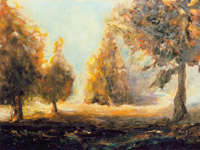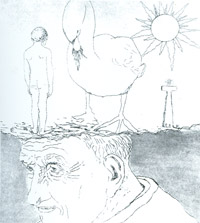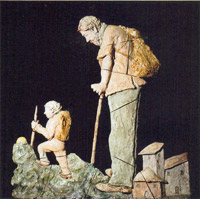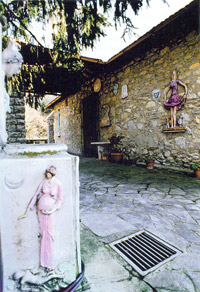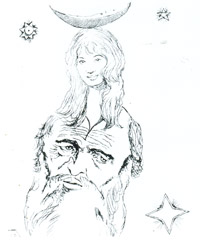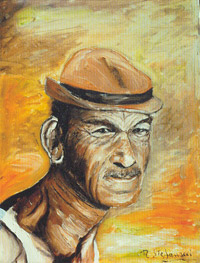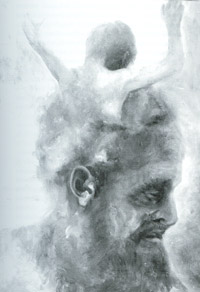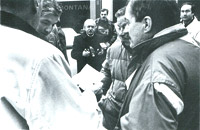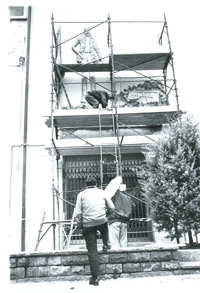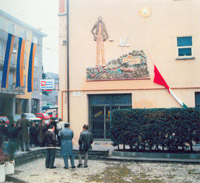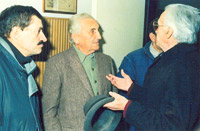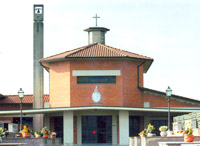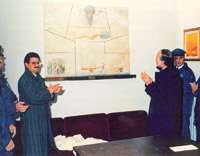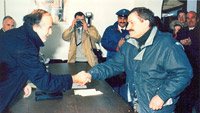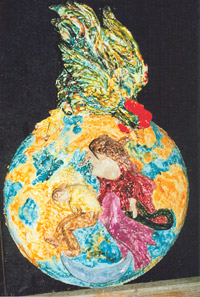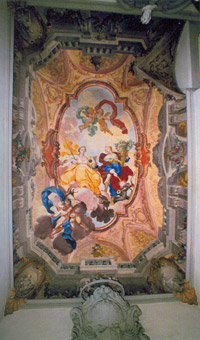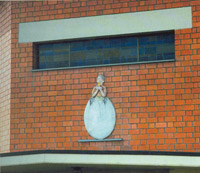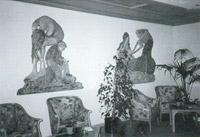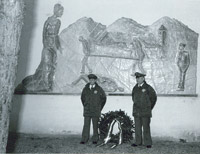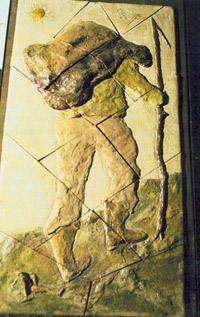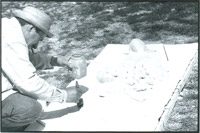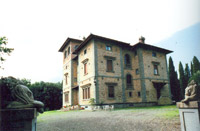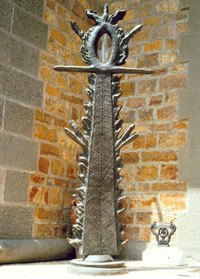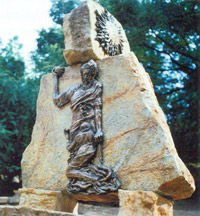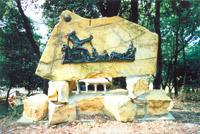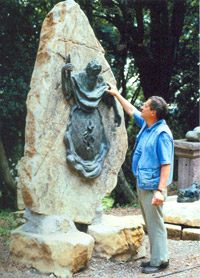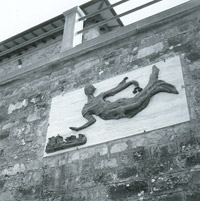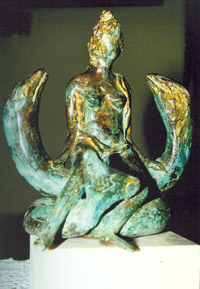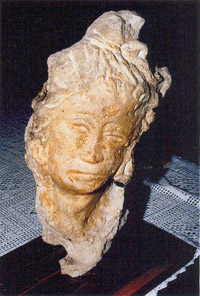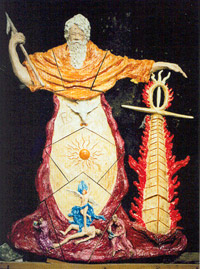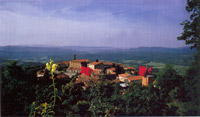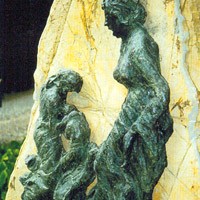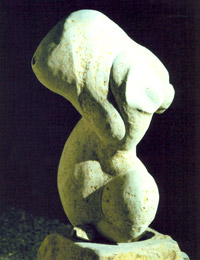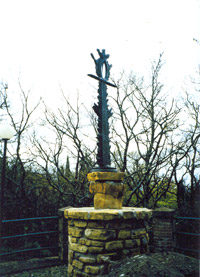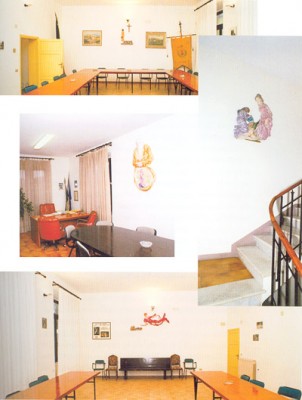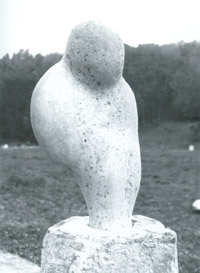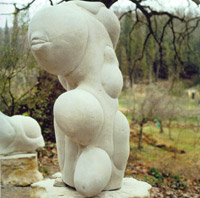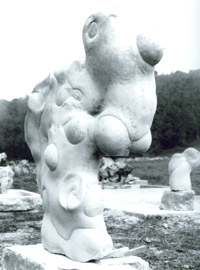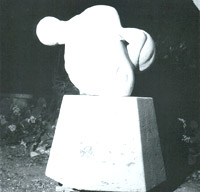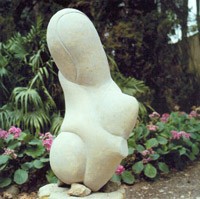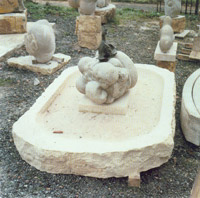Rolando Stefanacci Artist.
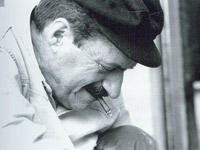 Rolando Stefanacci was born at Vernio (Prato) on August 5th, 1931 and lived in the ville “Il Gabbiano” in Comune of Vaiano for several years. In 1993 he moved to Monteverdi Marittimo in the Municipality of Pisa and settled in the villa “Le Querciaiole” which he transformed into a large park-museum. Not flattered by the exhibition activity (which also gave him satisfaction and approval), Stefanacci made numerous sculptures and ceramics for the municipalities of Prato, Monghidoro, Agliana, Monteverdi and several other cities in Tuscany, for Germany and, recently, for the ‘Australia, with the project of a large fountain for a square in Sidney.
Rolando Stefanacci was born at Vernio (Prato) on August 5th, 1931 and lived in the ville “Il Gabbiano” in Comune of Vaiano for several years. In 1993 he moved to Monteverdi Marittimo in the Municipality of Pisa and settled in the villa “Le Querciaiole” which he transformed into a large park-museum. Not flattered by the exhibition activity (which also gave him satisfaction and approval), Stefanacci made numerous sculptures and ceramics for the municipalities of Prato, Monghidoro, Agliana, Monteverdi and several other cities in Tuscany, for Germany and, recently, for the ‘Australia, with the project of a large fountain for a square in Sidney.
A sculptor who has chosen the alchemical path to interpret his works, germinated by the knowledge of esoteric philosophies and masters of life from all over the world.
…”la verità è come un grande albero, più viene curato e più da frutti; e più si scava nella miniera della verità, più vi scoprono le ricche gemme che vi sono sepolte”…
M. K. Ghandi
The Discovery of Painting
“When you come to knowledge comes physical death”.
It might seem like a big and subtly presumptuous sentence. It might sound a big and subtly conceited sentence. Rolando Stefanacci tells so in strong belief, as a man that has left materialism behind, to give himself up to spirituality.
It’s just clearly symbolic, in order to underline how his search, through esoteric studies and alchemy, later related to his sculptures of the last 20 years, is based on some beliefs come to surface and then exploded out of his alchemic, cabalistic/hermetic knowledge and of his reading of Egyptian hieroglyphics that put it on a mental dimension overcoming and even forgetting the traditional criteria of reality, to impose a strictly personal perspective, what himself calls “his own reality”.
A preface which will turn out necessary on coping with the analysis both of his life and of his artistic work, just because symbols, the essence of things, are the ground of his search, or better his
initiatory message. An alchemy that consists of transforming metals into gold, but that means fundamentally the transformation of man into pure spirit, and that also represents human evolution from a merely material condition to a spiritual one. Here lies the link to Stefanacci’s search, often so hermetic both in his expression and in the representation of his works that it sometimes disconcerts the viewer or whoever may want to analyse his message thoroughly or try to reach its most hidden meanings.
It is therefore necessary to stop and medidate long, especially on the small and big sculptures which have been or are travelling around the world, all deeply imbued with pregnant spirituality, where the alchemic process is just the path of his work,
never allegoric but always symbolic.(1) A remark that cannot ever be trivial because it helps stimulating a desire to come back to the ancient splendour of virtue, knowledge and wisdom in anybody who watches as well as in the one who analyses.
“Il nonno” (1985)
A long anticipation before going along Stefanacci’s path through the gradual growth of his being an artist, maybe conscious to be so since childhood, when he had artistic aspiratons that would bloom later.
Una veduta del cortile della villa “Il Gabbiano”
A place rich in historical traditions, where Rolando – seventh of eight brothers – stole the secrets of nature that surrounded him with an eye always attentive to the human material which will then be at the center of his interest, especially when his frantic search will be purified in some way from the aesthetic fact to privilege only interiority and spirituality through an alchemical methodology.
A symbolic graphic work from the early period
From a very young age, at school, he loved portraying the faces of his classmates, family members, who were his first discoveries and who perhaps at an unconscious level tempted him, precisely because in observing them he was already led more to investigate moods than not. outlines and facial features. Yes, this is an intuition of future research. In his childish mind he perhaps cherished the hope of becoming a painter when he grew up. But he had read somewhere that “he who lives on painting dies at the retired people’s home”, and thus the wish to to get the so called “position” prevailed somehow, and young Stefanacci devoted himself to work and dealt with the stuff that had made Prato’s fortune since the 16th Century; wool and its hundreds of elaborations, renamed all over the world so much to make Prato the “Tuscan Manchester” Thus his youth painting attempts were put aside for a long time.
Thus his youth painting attempts were put aside for a long time.
Ritratto di Mannini (1969)
But from the “Gull’s hill”, a rock over la Briglia, where his family had moved from Vernio, powerful came the call of the art which was inside him, and which urged him so much to drive him back to handle brushes and colours again. Many years had gone by, but what had been a youth gift hadn’t faded: in the early Sixties he had exhibited his works at Giorgi’s gallery in Florence for the first time, which had got his first review thanks to those Tuscan landscapes of melancholy and those faces carved by suffering, generally belonging to common people, and manners portraits and magnetic-eyed ladies.
Stefanacci admits to have been fascinated by the great masters of the past, Impressionists above all, from Degas to Manet, from Renoir to Toulouse-Lautrec, up to the greet ‘800 Neapolitons, on visiting French and Swiss museums. He had perceived in their strong colour contrasts, a subtle symbolism and, although by intuition, he had transferred it into his own works, driving Cecilia Toschi to write in a clear article on October 7 973 “Eco d’Arte” that “…an echo of this figurative world of ours remains in some works of the artist, though revised in more homogenous and relaxed emotions, leaving more space to colour details and chiaroscuro resonance…”; and then tell about on “the warm colours that the artist manages vigorously to exploit to his own advantage, by focusing with light touches the core of the work, the theme he cares the most….
La Rinascita (1960)
Stefanacci nearly hedges when he is asked to tell about the milestones of his life, especially the early ones, so far in the memory by now, and from today’s researches all aiming at more real targets.
“Why, would you make them better?” was the answer of his son. That was how it started again.
After his first exhibition, others followed even if Stefanacci never believed in fame through public proposition. Moreover – also stimulated by friends and admirers, he sent some of his paintings to the painting prizes (more for verification than anything else) and in ’68 he hit the mark in a competition dedicated to Vittorio De Sica in Rome in which three hundred Italian painters had participated, obtaining the first prize that was awarded to him during the “night of the oscars”. For this reason, it deserved to be published in the magazine “Arte mercato”, an international monthly of contemporary art. He was defined, in the motivation, “the painter of meditation and silence” and in his Tuscan landscapes “deep tones and contents, vibrant like musical notes that give the sensation of an intimate rhythmic language” were recognized.
Stefanacci is almost shy when he is asked to tell the stages of his life, especially the initial ones, now distant in memory and from current research all aimed at more concrete objectives. But this too belongs to a story, to a path, yet we can say that it’s just the ground of a wide range search such as Stefanacci’s has always been by a constant suffering, yesterday painting and ceramics, today sculpture born by the meanders of inner life, elicited by deep studies linked to the Real Art, that’s alchemy, nothing but a natural mirror of revealed truth, or psychical metamorphosis art.It’s a time,
the one between the Sixties and Seven ties, of great fruitfulness, even though Stefanacci doesn’t attend Galleries because he works almost exclusively for himself only. But it’s a work that doesn’t get over sighted: his “old people” with their carved faces where the suffering of an entire mankind seems to come to surface, filtered by their dramatic looks – on inquiring about human condition- are pointed out by critics, and Stefanacci gets listed in “Quadrato”where Wilson Domma writes that “…in his pictures a variant can be noticed necessary to increase the emotions that helps dramatize the subject, to suggest it again according to a new scale of more effective values…” And it’s also something that foreshadows a natural shift to sculpture by its plasticity due to Stefanacci’s inner disposition to give matter a shape.
In the meanwhile, already since the end of the Fifties, Stefanacci faces deep alchemic -philosophic studies by meeting masters of research from all over the world:
these studies, which modify his way of thinking partially, get mixed to his recovered artistic search and influence formal and content results heavily, both about oil paintings (abandoned later) and about graphics, ceramics and buildings as well as stone and bronze scuIpture. It’s a gradual upsetting of ideas that gets total gradually: its external, let’s say aesthetic feature, that has never played a main role, turns into symbolic meanings embodied by a deeper and deeper study of alchemy meant as a ‘godless’ knowledge-based mysticism.
1) “True symbolism implies that things different by time space, shape, and other circumstances, can shore the same being. “(T Burckhardt)

